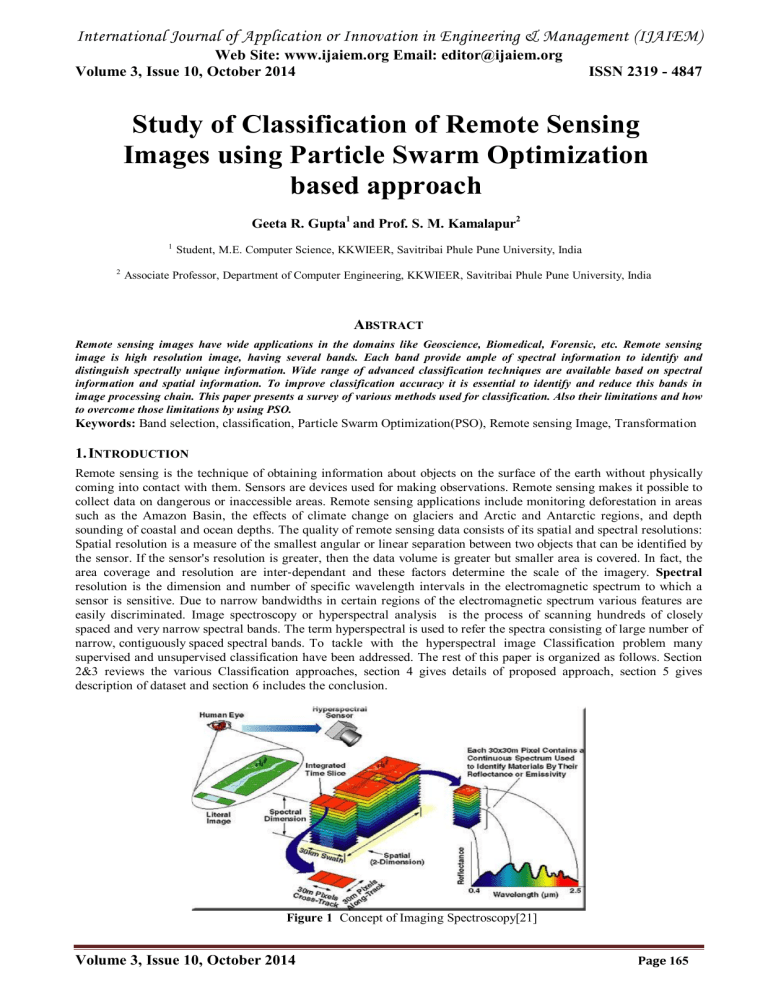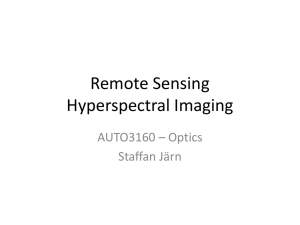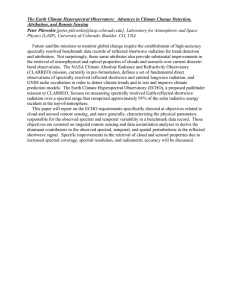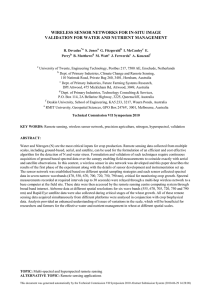Study of Classification of Remote Sensing Images using Particle Swarm Optimization

International Journal of Application or Innovation in Engineering & Management (IJAIEM)
Web Site: www.ijaiem.org Email: editor@ijaiem.org
Volume 3, Issue 10, October 2014 ISSN 2319 - 4847
Study of Classification of Remote Sensing
Images using Particle Swarm Optimization based approach
Geeta R. Gupta
1
and Prof. S. M. Kamalapur
2
1
Student, M.E. Computer Science, KKWIEER, Savitribai Phule Pune University, India
2
Associate Professor, Department of Computer Engineering, KKWIEER, Savitribai Phule Pune University, India
A BSTRACT
Remote sensing images have wide applications in the domains like Geoscience, Biomedical, Forensic, etc. Remote sensing image is high resolution image, having several bands. Each band provide ample of spectral information to identify and distinguish spectrally unique information. Wide range of advanced classification techniques are available based on spectral information and spatial information. To improve classification accuracy it is essential to identify and reduce this bands in image processing chain. This paper presents a survey of various methods used for classification. Also their limitations and how to overcome those limitations by using PSO.
Keywords: Band selection, classification, Particle Swarm Optimization(PSO), Remote sensing Image, Transformation
1.
I NTRODUCTION
Remote sensing is the technique of obtaining information about objects on the surface of the earth without physically coming into contact with them. Sensors are devices used for making observations. Remote sensing makes it possible to collect data on dangerous or inaccessible areas. Remote sensing applications include monitoring deforestation in areas such as the Amazon Basin, the effects of climate change on glaciers and Arctic and Antarctic regions, and depth sounding of coastal and ocean depths. The quality of remote sensing data consists of its spatial and spectral resolutions:
Spatial resolution is a measure of the smallest angular or linear separation between two objects that can be identified by the sensor. If the sensor's resolution is greater, then the data volume is greater but smaller area is covered. In fact, the area coverage and resolution are inter ‐ dependant and these factors determine the scale of the imagery. Spectral resolution is the dimension and number of specific wavelength intervals in the electromagnetic spectrum to which a sensor is sensitive. Due to narrow bandwidths in certain regions of the electromagnetic spectrum various features are easily discriminated. Image spectroscopy or hyperspectral analysis is the process of scanning hundreds of closely spaced and very narrow spectral bands. The term hyperspectral is used to refer the spectra consisting of large number of narrow, contiguously spaced spectral bands. To tackle with the hyperspectral image Classification problem many supervised and unsupervised classification have been addressed. The rest of this paper is organized as follows. Section
2&3 reviews the various Classification approaches, section 4 gives details of proposed approach, section 5 gives description of dataset and section 6 includes the conclusion.
Figure 1 Concept of Imaging Spectroscopy[21]
Volume 3, Issue 10, October 2014 Page 165
International Journal of Application or Innovation in Engineering & Management (IJAIEM)
Web Site: www.ijaiem.org Email: editor@ijaiem.org
Volume 3, Issue 10, October 2014
2.REMOTE
SENSING IMAGES
ISSN 2319 - 4847
There are various types of remote sensing images, which are as follows:
2.1
Multispectral Image
A multispectral image consists of several bands of data. The bands in multispectral image are less than 30.This depends on the application and it is always less than 30 bands.
2.2
Superspectral Image
Recent satellite sensors are capable of capturing images at many more wavelength bands. For example, several satellites consist of 36 spectral bands, covering the wavelength regions ranging from the visible, near infrared, shortwave infrared to the thermal infrared. Bandwidth of the bands are narrower, allowing the finer spectral characteristics of the targets to be captured by the sensor. The term "superspectral" refer such sensors.
2.3
Hyperspectral Image
A hyperspectral image consists of hundred or more contiguous spectral bands forming a three-dimensional (two spatial dimensions and one spectral dimension) image cube. Dimenstionality reduction has been widely used in hyperspectral image analysis to reduce data volume and redundancy.
3.H
YPERSPECTRAL I MAGE C LASSIFICATION
Hyperspectral image classification is the process of producing thematic maps from remote sensing image. A thematic map represents the objects present on the surface of earth (Soil, vegetation, roof, road, buildings) and its construction expresses the themes or categories selected for the map are distinguishable in image. The remote sensing classification involves clustering the pixels of an image into set of classes having similar properties. One of the major problems in remote sensing is huge amount of data that is available for processing. To deal with this data explosion problem, internal and fuzzy methods were employed [4]. Majority of Image classification is based on the detection of the spectral response patterns of land cover classes. The major objective of image classification is to automatically categorize all pixels in image into appropriate land cover classes [2] . Image classification can be done by either based on pixel information or based on use of training samples.
3.1
Image classification based on pixel information
Based on the information of pixel, images can be classified as Per-Pixel, Sub Pixel, Per-field, Knowledge based,
Contextual and multiple Classifiers.
Per-Pixel Classifier is a classifier in which image classification is done by processing the entire image pixel by pixel referred as pixel-based classification. In this each pixel is classified in only one category [2]. Per pixel classifiers may be parametric or non parametric. Commonly used Parametric Classifiers are Maximum likelihood classifier.
Commonly used non-parametric classifiers are neural networks, Decision tree and Support Vector Machine. To improve performance in a non-parametric classification procedure, boosting, bagging or a hybrid of both techniques can be used. These methods can be used in decision trees and Support Vector Machine [5],[6]. In most applications perpixel classifiers are not suitable because they can basically handle spectral information only. In Sub pixel classifier, each pixel is classified into only one category and the land cover classes are mutually exclusive. It deals with mixed pixel problems. As compared to per-pixel approaches this classification approaches have been developed for providing more appropriate representation and accurate area estimation of land covers especially when coarse spatial resolution data are used [8],[9]. Commonly used classifiers in sub pixel classifications are spectral unmixing, spectral mixture analysis.
Per-field classifier first divides the image into homogeneous image segments using an extended version of the
Gaussian Maximum Likelihood (GML) algorithm. Per-field classifier classifies landuse by predetermined field boundaries, by making an assumption that each field belongs to a single, homogeneous class[10],[11],[12]. Per-field classification is developed to overcome the limitations and weakness of per pixel classification.
Contextual classifier is a classifier which uses the spectral information at each pixel to predict the class of that pixel independently by making observations at other pixels. Also it uses the information from other neighboring pixels. The spatially neighboring pixel information is used in contextual classifiers. Contextual classifiers were developed to overcome with the problem of intraclass spectral variations [13]. For improving the classification performance, it exploits spatial information among neighboring pixels [14]. Also it may use smoothing techniques, neural networks and segmentation. Most frequently used approach is Markov random field-based contextual classifiers [14].
Knowledge based classifier is a classifier which is more suited to handle complex data. Different kinds of ancillary data, such as digital elevation model, housing, soil map and temperature are easily available; they may be integrated into a classification procedure in different ways. One approach is to develop knowledge based classifications based on the spatial distribution pattern of land cover classes and selected ancillary data. Developing the rules that can be used in an expert system is an critical step.
Volume 3, Issue 10, October 2014 Page 166
International Journal of Application or Innovation in Engineering & Management (IJAIEM)
Web Site: www.ijaiem.org Email: editor@ijaiem.org
Volume 3, Issue 10, October 2014 ISSN 2319 - 4847
3.2
Image classification based on training samples
Training Samples can be categorized as Supervised Classification and Unsupervised Classification.
Supervised classification requires training data in order to build an predictive model. The training data set is obtained by registring the calibrated hyperspectral imagery with ground measurements. Supervised methods are computationally intensive than unsupervised methods due to an arbitrarily high model complexity and an iterative nature of model formation. Another requirement is that the number of examples in a training set should be larger than the number of attributes (i.e bands). This requirement might be hard to meet. In general, supervised classification, can be classified into two approaches : Filter approach It is based on optimising a discrimination measure, such as the Mahalanobis distance, Bhattacharyya distance, etc. The filter approach is performed independently from any classification algorithm, so before the classification process begins unwanted features are omitted or filtered. Wrapper approach - It optimizes the classification accuracy of the desired classifier by selecting feature subsets. In supervised Classification,
Land cover classes are defined. Sufficient reference data are available and this data are used as training samples [16].
Most commonly used supervised classification approaches are maximum likelihood, neural network and decision tree.
Supervised Classification is one of the tasks carried out by Intelligent System. A large number of methods have been developed based on Perceptron based techniques (i.e) Feed Forward Networks[17]. In contrast to supervised approach,
Unsupervised classification order hyperspectral bands without any training and the methods are based on generic information evaluation approaches. Unsupervised methods are usually very fast and computationally efficient. These methods require very little or no hyperspectral image pre-processing. In this clustering based algorithms are used for partitioning the spectral image into a number of spectral classes based on the statistical information inherent in the image. No prior definitions of the classes are used. The unsupervised classification approaches are ISODATA and Kmeans Clustering Algorithm. One of the methods used in unsupervised classification technique is ISODATA [18] it uses a maximum- likelihood decision rule to calculate class. K- Means clustering [19] is a common method used to automatically partition a dataset into k groups.
4.P
ROPOSED M ETHOD
An advanced but simple searching strategy is particle swarm optimization (PSO), originally developed by Kennedy and
Eberhart. This method is for optimizing difficult numerical functions on metaphor of social behaviors of flocks of birds and schools of fish. It is an evolutionary technique based on swarm intelligence. A swarm consists of individuals, which are called particles, that change their positions over time. Each particle represents a solution to the problem. Figure 2. shows the block diagram of the proposed system. Thus in the proposed system, PSO based approach is used for feature selection in order to reduce the dimenstionality of hyperspectral data. This approach of feature selection can offer the best and smallest band subset selection as compared to the existing methods in the literature [20]. Initially some feature are extracted from the image then based on that attribute processing will be done. This will be given to PSO which will perform feature selection(i.e. band selection) and hence will reduce the dimenstionality. All the fuzzy values and random values can be handeled by Gaussian mixture model and expectation maximization. Finally based on this selected features image is classified.
Figure 2. Block Diagram
5.DISCUSSION
5.1 Dataset
These datasets include AVIRIS, HYDICE which are freely available online from [22]. Airborne Hyperspectral Sensors includes Airborne Visible/infrared Imaging Spectrometer (AVIRIS) . The information of these datasets is a sub image of size 350×350 with 224 bands of a data set taken on the AVIRIS flight of June 19, 1997. The instrument of AVIRIS covers 0.41 – 2.45 μm regions in 224 bands with a 10 nm bandwidth and flying at an altitude of 20 km.
Volume 3, Issue 10, October 2014 Page 167
International Journal of Application or Innovation in Engineering & Management (IJAIEM)
Web Site: www.ijaiem.org Email: editor@ijaiem.org
Volume 3, Issue 10, October 2014 ISSN 2319 - 4847
6. CONCLUSION
In this paper, literature survey of the various methods used for classification of remote sensing images are depicted.
Hyperspectral image classification uses various features such as spectral, spatial, multitemporal and multi sensor information. Based on error matrix and fuzzy approaches accuracy verifications are done . Most important factors in classification accuracy are uncertainty and error propagation chain. Identifying the weakest links in the chain and then reducing the uncertainties are necessary for improvement of classification accuracy. To tackle with this, a novel approach of optimizing the bands using PSO is introduced. Investigation can be further done on how to design better mechanisms to generate more accurate classification of the image.
References
[1] Tadjudin, S., & Landgrebe, D. (1998). Classification of high dimensional data with limited training samples.
Available online: http://dynamo.ecn.purdue.edu/ landgreb/Saldju_TR.pdf
[2] Lu .D & Weng.Q, (2007), A Survey of Image Classification methods and techniques for improving classification
Performance, International Journal of Remote Sensing, 28, 5, 823- 870.
[3] Tilton, J. C. (2006). RHSEG and HSEGViewer user's Manual, Provided with the demonstration version of
RHSEG. available from: http://ipp.gsfc.nasa.gov/RHSEG (version 1.25 released Dec. 14, 2006).
[4] Starks,S.A. and EI Paso,(2001), Internal and fuzzy methods in remote sensing and satellite image processing, 18
,2019-2022
[5] Friedl, M.A, Brodley C.E, and Strahler A.H ,(1999), Maximizing land cover classification accuracies produced by decision trees at continental to global scales, IEEE Transactions on Geoscience and Remote Sensing, 37,969-977.
[6] Lawrence R,Bunn.A, Powell.s and Zmabon .M, (2004),Classification of Remotely Sensed imagery using stochastic gradient boosting as a refinement of classification tree analysis. Remote Sensing of Environment, 90,331-336.
[7] Kettig.R.L and Landgrebe.D.A, (1976), Classification of multispectral image data by extraction and classification of homogenous objects, IEEE transactions on Geoscience Electronics, 19-26.
[8] Foody G.M, Cox D.P., (1994), Subpixel landcover composition estimation using a linear mixture model and fuzzy membership functions, Int. Remote sensing, 15, 619- 631
[9] Binaghi, E. Brivio, P.A, Ghezzi.P and Rampini.A, (1999), A Fuzzy set accuracy assessment of Soft
Classification. Pattern Recognition Letters, 20,935-948
[10] Aplin,P. Atkinson ,M.P,Curran,J.P., (1999), Fine spatial resolution simulated satellite sensor imagery for land cover mapping in the united kingdom, Remote sensing of environment, 66, 206- 216
[11] Fuller, R., Smith, G., Sanderson, J., Hill, R. and Thomson, A.,(2002), The UK Land Cover Map
Construction of a parcel-based vector map from satellite images. The Cartographic Journal, 39, 15–25.
2000:
[12] Erol.H and Akdeniz.F, (2005), A per field classification method based on mixture distribution models and an application to land sat thematic mapper data, International Journal of Remote sensing, 26, 1229 – 1244
[13] Gong.P and Howaeth P.J, (1992), Frequency-based contextual classification and gray level vector reduction for land use identification, Photogrammetric Engineering and Remote sensing,,58,423-437.
[14] Magnussen.S, Boudewyn.P and Wulder.M, (2004), Contextual Classification of Landsat TM images to forest inventory cover types. International Journal of Remote Sensing. 24 2421-2440
[15] Hodgson. M.E , John R.Jensen, Jason A.Tullis, Kevin .D.Riordan and Clerk M.Archer, (2003), Synergistic use
Lidar and color Arial photography for mapping urban parcel imperviousness, Photogrammetric Engineering and remote sensing, 69, 973 - 980
[16] Lu .D & Weng.Q, (2007), A Survey of Image Classification methods and techniques for improving classification
Performance, International Journal of Remote Sensing, 28, 5, 823- 870.
[17] Kotsiantis.S.B, (2007), Supervised Machine Learning: A Review of Classification Techniques, Informatica 3, 249-
268.
[18] Melesse .M. A and Jordan,J.D, (2002), Photogrammetric Engineering and Remote Sensing, 68.
[19] Wagstaff,K. and Cardie,C. (2001),Constrained K-means clustering with background knowledge, Proceedings of the eighteenth international conference on machine learning , 577 – 584.
[20] H. Yang, Q. Du, and G. Chen, “Particle swarm optimization-based hyperspectral dimensionality reduction for urban land cover classification,” IEEE J. Sel. Topics Appl. Earth Observ. Remote Sens., vol. 5, no. 2, pp. 544–
554, Apr. 2012.
[21] Bijay Singh and Jimly Dowerah(2010)," Hyperspectral Imaging: New Generation Remote Sensing"Open access e-
Journal Earth Science India, Vol. 3 (III), July, 2010.Popular Issue, http://www.earthscienceindia.info/; ISSN:
0974 – 8350
[22] http://dynamo.ecn.purdue.edu/biehl/MultiSpec.
Volume 3, Issue 10, October 2014 Page 168
International Journal of Application or Innovation in Engineering & Management (IJAIEM)
Web Site: www.ijaiem.org Email: editor@ijaiem.org
Volume 3, Issue 10, October 2014 ISSN 2319 - 4847
AUTHOR
Geeta R. Gupta received the B.E. degree in Computer Engineering from R. H. Sapat College of Engineering and
Research in 2013. She is currently pursuing her Masters degree in Computer Engineering from K. K. Wagh Institute of
Engineering Education and Research, Savitribai Phule Pune Universoty Former UoP. This paper is published as a part of research work done for the Masters degree.
Volume 3, Issue 10, October 2014 Page 169





